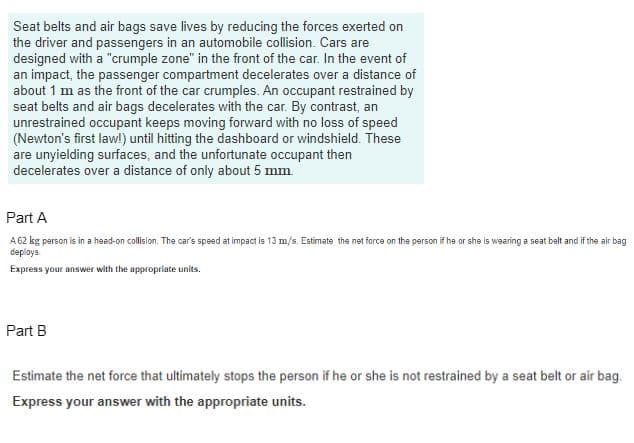Seat belts and air bags save lives by reducing the forces exerted on the driver and passengers in an automobile collision. Cars are designed with a "crumple zone" in the front of the car. In the event of an impact, the passenger compartment decelerates over a distance of about 1 m as the front of the car crumples. An occupant restrained by seat belts and air bags decelerates with the car. By contrast, an unrestrained occupant keeps moving forward with no loss of speed (Newton's first law!) until hitting the dashboard or windshield. These are unyielding surfaces, and the unfortunate occupant then decelerates over a distance of only about 5 mm Part A A 62 kg person is in a head-on collision. The car's speed at impact is 13 m/s. Estimate the net force on the person if he or she is wearing a seat belt and if the air bag deploys Express your answer with the appropriate units. Part B Estimate the net force that ultimately stops the person if he or she is not restrained by a seat belt or air bag. Express your answer with the appropriate units.
Seat belts and air bags save lives by reducing the forces exerted on the driver and passengers in an automobile collision. Cars are designed with a "crumple zone" in the front of the car. In the event of an impact, the passenger compartment decelerates over a distance of about 1 m as the front of the car crumples. An occupant restrained by seat belts and air bags decelerates with the car. By contrast, an unrestrained occupant keeps moving forward with no loss of speed (Newton's first law!) until hitting the dashboard or windshield. These are unyielding surfaces, and the unfortunate occupant then decelerates over a distance of only about 5 mm Part A A 62 kg person is in a head-on collision. The car's speed at impact is 13 m/s. Estimate the net force on the person if he or she is wearing a seat belt and if the air bag deploys Express your answer with the appropriate units. Part B Estimate the net force that ultimately stops the person if he or she is not restrained by a seat belt or air bag. Express your answer with the appropriate units.
College Physics
1st Edition
ISBN:9781938168000
Author:Paul Peter Urone, Roger Hinrichs
Publisher:Paul Peter Urone, Roger Hinrichs
Chapter4: Dynamics: Force And Newton's Laws Of Motion
Section: Chapter Questions
Problem 16CQ: A device used since the 1940s to measure the kick 01 recoil of the body due to heartbeats is the...
Related questions
Topic Video
Question
100%

Transcribed Image Text:Seat belts and air bags save lives by reducing the forces exerted on
the driver and passengers in an automobile collision. Cars are
designed with a "crumple zone" in the front of the car. In the event of
an impact, the passenger compartment decelerates over a distance of
about 1 m as the front of the car crumples. An occupant restrained by
seat belts and air bags decelerates with the car. By contrast, an
unrestrained occupant keeps moving forward with no loss of speed
(Newton's first law!) until hitting the dashboard or windshield. These
are unyielding surfaces, and the unfortunate occupant then
decelerates over a distance of only about 5 mm.
Part A
A 62 kg person is in a head-on collision. The car's speed at impact is 13 m/s. Estimate the net force on the person if he or she is wearing a seat belt and if the air bag
deploys.
Express your answer with the appropriate units.
Part B
Estimate the net force that ultimately stops the person if he or she is not restrained by a seat belt or air bag.
Express your answer with the appropriate units.
Expert Solution
This question has been solved!
Explore an expertly crafted, step-by-step solution for a thorough understanding of key concepts.
This is a popular solution!
Trending now
This is a popular solution!
Step by step
Solved in 2 steps with 1 images

Knowledge Booster
Learn more about
Need a deep-dive on the concept behind this application? Look no further. Learn more about this topic, physics and related others by exploring similar questions and additional content below.Recommended textbooks for you

College Physics
Physics
ISBN:
9781938168000
Author:
Paul Peter Urone, Roger Hinrichs
Publisher:
OpenStax College

College Physics
Physics
ISBN:
9781938168000
Author:
Paul Peter Urone, Roger Hinrichs
Publisher:
OpenStax College